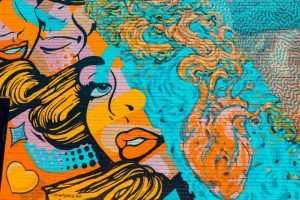Painting Tips – Painting The Right Brush For The Right Job: A blog about different painting methods and materials.
Let us assume that you want to paint the outside of a building that has some brickwork on it, maybe some woodwork and maybe some plaster work as well. What brush should you use?
First of all, there are two major types of paint brushes that you must consider: natural bristle brushes and synthetic brushes. Natural bristles are made from animal hair, typically hog hair or sable hair. Synthetic brushes are made from man-made materials such as nylon.
Paint your house with a natural bristle brush
Painters typically use the natural bristles because they can hold more paint, they have better spring, they do not lose their shape as fast and they last longer than the synthetic ones. As a result, most companies will supply these types of brushes to their painters and they can also be found at most hardware stores.
Having said this, if you are painting around the exterior of your home then it is quite possible that you may find that a synthetic brush may be just what you need. They are lighter in weight, which may mean that you can move them around more easily and quickly. In addition, the bristles
In the world of art, people refer to a lot of different methods and materials. The subject can be daunting for an artist who is just starting out, because the terminology is not always explained well.
The terms used in the art world can be confusing for those who do not have any experience with them. This blog will help to clarify some of these terms and how they relate to one another.
The following are some of the more popular painting tips:
Different types of brushes and their uses:
Large brushes are used for covering larger areas such as backgrounds or others that require less detail. They are also used when painting broad strokes such as sky or grass. These brushes are also good for making large flow lines in watercolor paintings.
When you want to paint small details, you will use a smaller brush like a filbert or a flat brush. The filbert brush has tapered bristles while the flat brush is completely flat on both sides. Mixing various size brushes helps you get the right texture and value you need in your painting.
Tight round brushes are great for detail work like painting faces or hands as they allow for precision work around eyes, mouth, and other small areas. These brushes are also good for decorative edging on paintings, as
The right brush for the right job. It’s a pretty simple concept, but one that is not always easy to put into practice.
You see, there are basically 2 types of brushes: natural and synthetic. And each type can be used for very different applications. But what exactly is the difference between them?
Well, let’s start with natural brushes…
Whether you are an artist painting a masterpiece or a DIY enthusiast painting your living room, having the right brush can make a big difference in your finished product.
There are many different brushes and each is best suited for certain applications. Knowing which to use is important because each brush has its own characteristics. Some have stiffer bristles while others are softer. Some hold more paint than others and some have longer handles. You can find all of these brushes in a standard set of brushes or you can purchase them individually for a variety of projects.
Let’s take a look at some of the most common types of brushes and how they are used.
Artists have different painting styles and painting techniques, which is why it’s good to know the basics of these. The most important thing for artists to decide is which brush to use for a particular painting technique because this will determine how well the painting looks.
What’s the best brush for watercolor painting? What about acrylic, oil pastel or linoleum block printing? Is there a special brush for portraits? All of these questions will be answered in this article. This will help you choose the right brushes and make your paintings look more professional and better.
The first thing to understand is that you don’t need a lot of expensive equipment to be a good artist. If your aim is to paint watercolor landscapes, then you may need only a few brushes and some paints. However, if you want to do oil paintings, you will need more specialized materials and brushes, but the quality of the painting does not depend on the equipment. The best advice is to start with a limited collection and add more materials as needed for specific projects.
Where to find cheap art supplies? If you are just starting out, I would recommend buying from local stores in your area. Most of them have great sales for students or beginners. You can also buy online at websites like Blick Art Materials or Dick Blick Art Materials.
Tackle one thing at a time – You can really get overwhelmed when trying to learn everything at once. It’s much easier to learn one technique and practice it until it becomes second nature before moving on to another technique. Start with easy painting techniques such as watercolor landscapes or black and white drawings. Then move on to bolder techniques like collages or abstract paintings. There’s no rush!
How many brushes should I have? To start off with a good selection of brushes, I would recommend purchasing an assortment
Most people think that if they are not artistic in nature, they can’t draw. That’s not true. You do not have to be an artist to draw (although it certainly helps!). You just need to take the time to learn the basics of drawing and practice.



